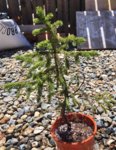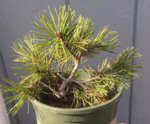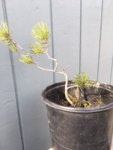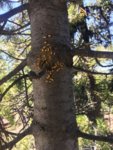amatbrewer
Shohin
While hiking I am constantly amazed by Whitebark Pines (Pinus albicaulis). I can sit and admire them for hours, and the more I learn the more I find to admire beyond their beauty. As they are a threatened species (but not yet protected) I am not willing to collect any from the wild. However I found a source of seedlings from LeBeau Bamboo Nursery so I purchased two last Oct to see how they do in my area (‘shrub steppe’ it is far from ideal for them). I will have to get some pix, but they are currently buried under 2 feet of snow. Being 2yo seedlings I the odds that the two I got will ever become much in the way of Bonsai is remote, but I would love to know as much about caring for them as possible and if they might respond to bonsai techniques (if so what?). Someday I hope to get my hands on some better material and when I do I want to be prepared to properly care for it.
In all my searching about all I have been able to learn so far in relation to Bonsai is that they are long lived but slow growing trees that need well-draining soil and can react negatively to fast releasing fertilizer. They have tight clumps of short needles that they retain for 5-8 years, and have persistent clumps of active buds that remain for decades near the base of the tree and the base of most branches (good back budding potential!). They are also susceptible to pine blister rust and pine beetle. One source says they are closely related to the Bristlecone Pine.
Given they live at high elevations, I assume they need extended cold dormancy and probably protection from my hot/dry summers (oops!). Also because of their natural habitat I assume they can handle drastic pruning (they naturally get damaged by heavy snow and winter storms), and I also assume they probably have naturally springy branches like subalpine fir, so may be difficult to set branches without extended wiring time or more drastic techniques.
When it comes to training, shaping, de-candling, and/or re-potting I have found virtually nothing, so I welcome any information that others may be able to provide.
In all my searching about all I have been able to learn so far in relation to Bonsai is that they are long lived but slow growing trees that need well-draining soil and can react negatively to fast releasing fertilizer. They have tight clumps of short needles that they retain for 5-8 years, and have persistent clumps of active buds that remain for decades near the base of the tree and the base of most branches (good back budding potential!). They are also susceptible to pine blister rust and pine beetle. One source says they are closely related to the Bristlecone Pine.
Given they live at high elevations, I assume they need extended cold dormancy and probably protection from my hot/dry summers (oops!). Also because of their natural habitat I assume they can handle drastic pruning (they naturally get damaged by heavy snow and winter storms), and I also assume they probably have naturally springy branches like subalpine fir, so may be difficult to set branches without extended wiring time or more drastic techniques.
When it comes to training, shaping, de-candling, and/or re-potting I have found virtually nothing, so I welcome any information that others may be able to provide.









